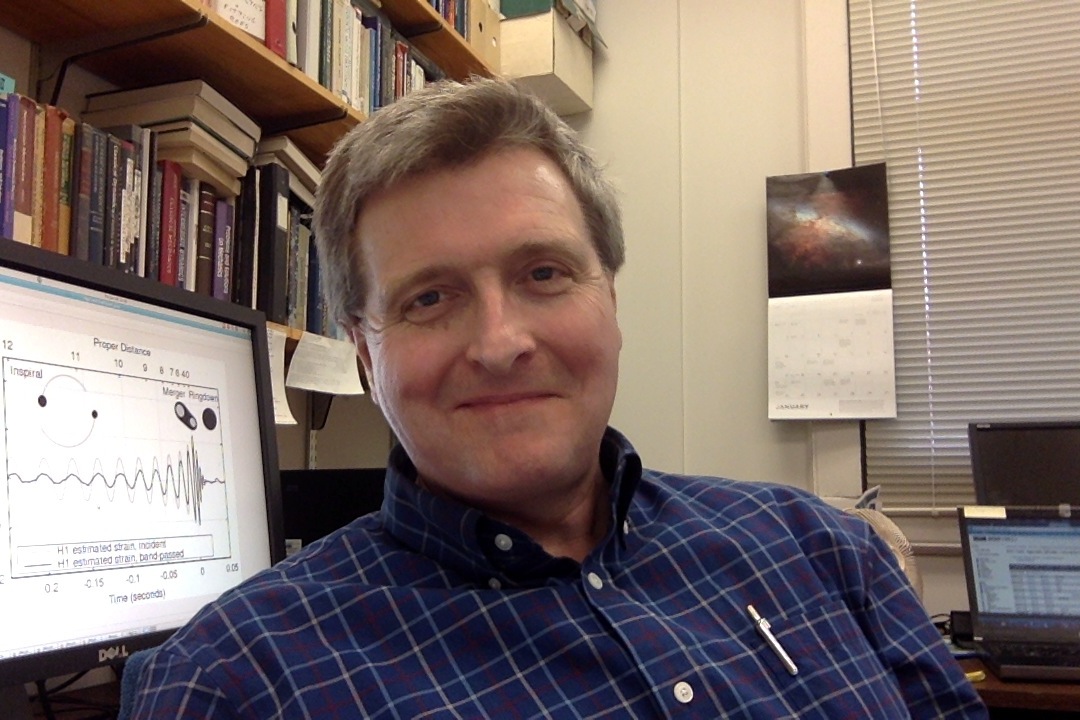Research:
Professor Riles carries out research into the fundamental
forces of nature, working in both gravitational wave
and elementary particle physics.
He leads the Michigan Gravitational Wave Group and is a member of the LIGO Scientific Collaboration (LSC),
which in September 2015 discovered gravitational waves from
the merger of two massive black holes. This $300 million project, led by Caltech and MIT, operates 4-km Michelson laser interferometers at sites in Hanford, Washington and Livingston, Louisiana. These interferometers are designed to measure minute disturbances in space itself to a relative precision better than 1 part in a billion trillion (10-21). Transient "ripples in space" can emanate from violent but distant astrophysical phenomena, including colliding black holes or neutron stars and from supernovae.
Using LIGO data, the Michigan Gravitational Wave Group has placed upper limits on longer-lived but still weaker (<10-24) ripples from unknown, rapidly spinning neutron stars in the Milky Way. Searches are now under way for gravitational waves emitted by isolated neutron stars using an algorithm called PowerFlux and for binary neutron stars, using an algorithm called TwoSpect. Both programs were developed by the University of Michigan group. In addition, the group has carried out extensive work on LIGO detector characterization, including calibration, and on detector commissioning.
Professor Riles has also spent part of his research time in recent years studying the physics potential and the detector requirements of a future linear electron positron collider with a center of mass energy of 350 GeV and higher.
Learn more about the Michigan Gravitational Wave Group
Learn more about Gravitational Waves: Sources, Detectors and Searches
[ K. Riles, Prog. Part. Nucl. Phys. 68, 1 (2013)]
Learn more about continuous gravitational waves:
Sampling of Presentations:
-
Gravitational Wave Astronomy -- Avant le De ́luge
8th Conference of the Polish Society on Relativity (Warsaw) September 19, 2022
-
Highlights from Recent LIGO and Virgo Observations
University of Michigan Physics Department Colloquium October 25, 2017
-
Observation of Gravitational Waves from a Binary Black Hole Merger
University of Michigan Physics Department Colloquium February 19, 2016
-
The Hunt for Gravitational Waves - Einstein was Right!
Saturday Morning Physics Lecture, February 20, 2016
-
Gravitational Waves - Einstein's Audacious Prediction
Saturday Morning Physics Lecture, February 13, 2016
-
Light of the Living Dead: The Remarkable Radiation from Neutron Stars
Saturday Morning Physics Lecture, October 31, 2009
-
Gravitational Waves -- Ripples of Space
Saturday Morning Physics Lecture I, May 7, 2005
-
How to Catch a Gravitational Wave
Saturday Morning Physics Lecture II, May 14, 2005
Former and Present Graduate Students:
-
Ph.D. Recipients:
- Yuan Zhou, 1997 (co-adviser with
B. Roe)
Measurement of the Bd Oscillation Frequency
using a Dilepton Sample
-
Ron Moore, 1997
Measurement of the Chirality Parameter in the Charged-Current Coupling of the Tau Lepton
-
Charles Leggett, 1998
Measurement of the Bottom-Quark Partial Decay Width of the Z using Multiple Independent Tags
-
Alan Button, 1999
Measurement of the W Boson Mass and Decay Width
-
Ross Berbeco, 2001
In Search of the Standard Model Higgs Boson
-
Jin Yamamoto,
2002
Search for the Standard Model Higgs Boson
in the Leptonic Channels
- David Chin,
2005
Exploratory Studies in a Search for Continuous-Wave Gravitational
Radiation in Early LIGO Data
- Vladimir Dergachev,
2009
An All-Sky Search for Continuous Gravitational Waves
- Evan Goetz,
2010
Gravitational Wave Studies: Detector Calibration and an All-Sky
Search for Spinning Neutron Stars in Binary Systems
- Grant Meadors,
2014
Directed searches for continuous gravitational waves from spinning neutron stars in binary systems
- Santiago Caride,
2015
Search for continuous gravitational waves from globular cluster NGC6544 using barycentric resampling
- Jaclyn Sanders,
2015
Advanced Gravitational Wave Detectors and Detection: Arm Length Stabilization and Directed Searches for Isolated Neutron Stars
- Orion Sauter,
2018
Searching for Continuous Gravitational Waves from Unknown Isolated Neutron Stars in Advanced LIGO Data
- Ansel Neunzert,
2019
Gravitational Waves From Spinning Neutron Stars: Development of a Directed Binary Search Technique and Spectral Characterization Tools
- Aashish Tripathee,
2022
An All-Sky Search for Continuous Gravitational Waves
- Jonathan Wang,
2024
Directed Semi-coherent Searches for Continuous Gravitational Waves from Supernova Remnants
Ph.D. Candidates:
Undergraduate Students:
-
Senior Thesis Projects: (ongoing or completed)
-
Jamie Rollins, 1998-1999 (co-adviser
with D. Gustafson)
Research at the 40-Meter LIGO Prototype Interferometer
-
Joseph Marsano, 2000-2001
Search for Gravitational Waves from Known Pulsars
-
Michael La Marca, 2002-2003
A Novel Interferometer Servo Control Scheme
-
Jacob Slutsky, 2003-2004
Search for Pulsar Gravitational Waves in Binary Systems
-
Sven Nyberg, 2005-2006
Frequency-Scanned Interferometry for Tracking Detector Alignment
-
Ramon Armen, 2005-2008
Detector Diagnostics for LIGO Gravitational Wave Detection
-
Pranav Rao, 2013-2016
Searching for periodicity in gamma-ray sources
-
Stephen Trembath-Reichert, 2015-2016
Spectral Line Artfact Investigations -- Tracking Time Dependence
-
Kaushik Rao, 2017-2018
Spectral Line Artifact Investigations -- Data Folding Studies
-
Charlie Badger, 2018-2020
Methods for detecting high-spindown Continuous Gravitational wave signals - Semi-analytical approaches
-
Sophie Hourihane, 2018-2020
The Viterbi Algorithm in the Search for Continuous Gravitational Waves
-
Grant Weldon, 2019-2021
Continuous Gravitational Wave Artifact Investigations
-
Sherman Thompson, 2020-2022
Enhancement of Integer-second Noise Analysis Tools for LIGO Gravitational Data
-
Clare Nelle (Hamilton College), 2023-2024
A Characterization of Loosely-coherent Searches for Continuous Gravitational Waves
-
Zihao Chen, 2023-2024
Enhanced Detection of Dark Photon Dark Matter Using Zero-Padding in Cross Correlation Techniques
LIGO Observational Results
L3 Publications

